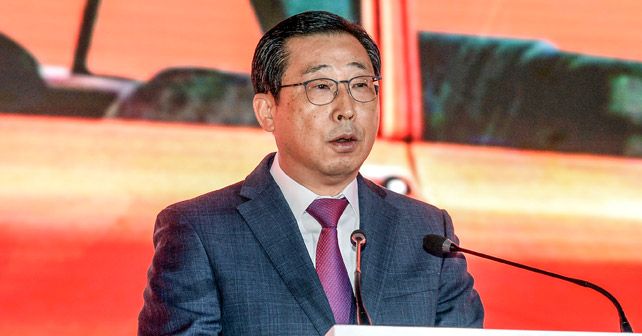We sat down with H.W. Park, President, Kia Motors Corporation, and Y. S. Kim, Executive Director, Kia Motors India, to know more about the Korean automaker’s plans for the Indian market.
How has the response been so far for Kia?
Park: It’s been very good. Maruti and Hyundai are very strong players, but fortunately they don’t have any major unveils at the show, so everyone is focussed on Kia – the newcomer!
What’s your product plan for India?
Park: The first car will be the SP Concept. The second one will be a small SUV, and if we succeeded with the small SUV, we will also consider a compact passenger car as well. If we were to bring in a small passenger car to begin with, we would lose out to Maruti and Hyundai – we know our position.
What is the status of the manufacturing plant?
Park: We are scheduled to have the first cars rolling off the assembly line in September 2019.
How will you sustain the excitement in the brand in the meantime?
Kim: Digital is a good way to connect and engage with people till we launch a car next year.
How many dealers do you plan to start with?
Kim: We will start where there are customers for these cars, which means that we have to start in the major cities. And then we will spread out to smaller cities. By 2020, we pan to cover more than 120 cities.
Have you decided the positioning of Kia in India relative to your sister company, Hyundai?
Kim: We are a trend-leading innovator. We have very trendy and sporty designs. This is unique in the industry. So this will be the big differentiator for us with other companies, including Hyundai. This point will lead the differentiation in our India-specific products as well. This will differentiate us not only from Hyundai but all other competitors as well. We will develop models for Indian customers with world-class quality.
You mentioned a compact EV for India specifically?
Park: Yes, we are considering one. We already have a Soul EV, and we will launch the Niro EV this year. Once we succeed with our two compact SUVs, we will consider launching a small EV in the Indian market. First we must succeed with these two models, otherwise there’s no sense in entering into EVs.
Kim: Moreover, the government infrastructure is not yet ready as yet.
What would it take to accelerate your EV plans in India – would you need strong incentives from the government and a clear indication of where policy is headed?
Park: Without some strong incentives, we cannot sell an EV in the Indian market. Not only in the Indian market, but all over the world incentives are required. But we are ready. The product is already there, and we are monitoring government policy and will decide accordingly.
Kim: If the government were to push an infrastructure company to lay down the charging stations required, this could be the incentive that we require. We should all work together.
300,000 is the production capacity for the plant. Will you start to export from India immediately?
Park: Yes, we will start export immediately.
Globally, how do you see the market developing over the next few years?
Park: Low growth is expected in the near future, especially in the US. China, as well, the growth rate is going down. Only the Indian market continues to grow. But, overall, the global market is likely to be a little depressed in future. We are here to enter the Indian market during a growing market.
Kia is known for its association with tennis and football. Is that something you feel you can leverage to build awareness in India?
Park: Indian people are very keen on cricket, but now the young generation is growing up with exposure to tennis and football as well – so our association with tennis and the FIFA world cup is very appropriate from an Indian point of view also. Plus, we have to find something India-specific that we can promote here as well.
Both you gentlemen have been in India before, what changes do you see in the country since the last time you were based here?
Park: In terms of infrastructure, a lot has changed. Also the variety of car models on the roads have increased exponentially. That’s a big change.
Is it easier to have launched a brand in India 10-15 years ago, when the awareness was less, or is it easier to launch a brand in India now – because awareness is higher and people are more open to newer brands?
Park: It would have been easier to enter in the early stages. I feel it’s a very big challenge to enter the Indian market now, but we will try and recover that disadvantage with good quality cars. We will customise cars for the Indian market.
What would you say to the Indian customer, what does the Kia brand stand for?
Park: Trend leading innovator – that is our brand philosophy, and in the first stage we will focus on the young and vibrant Indian consumer.

























Write your Comment